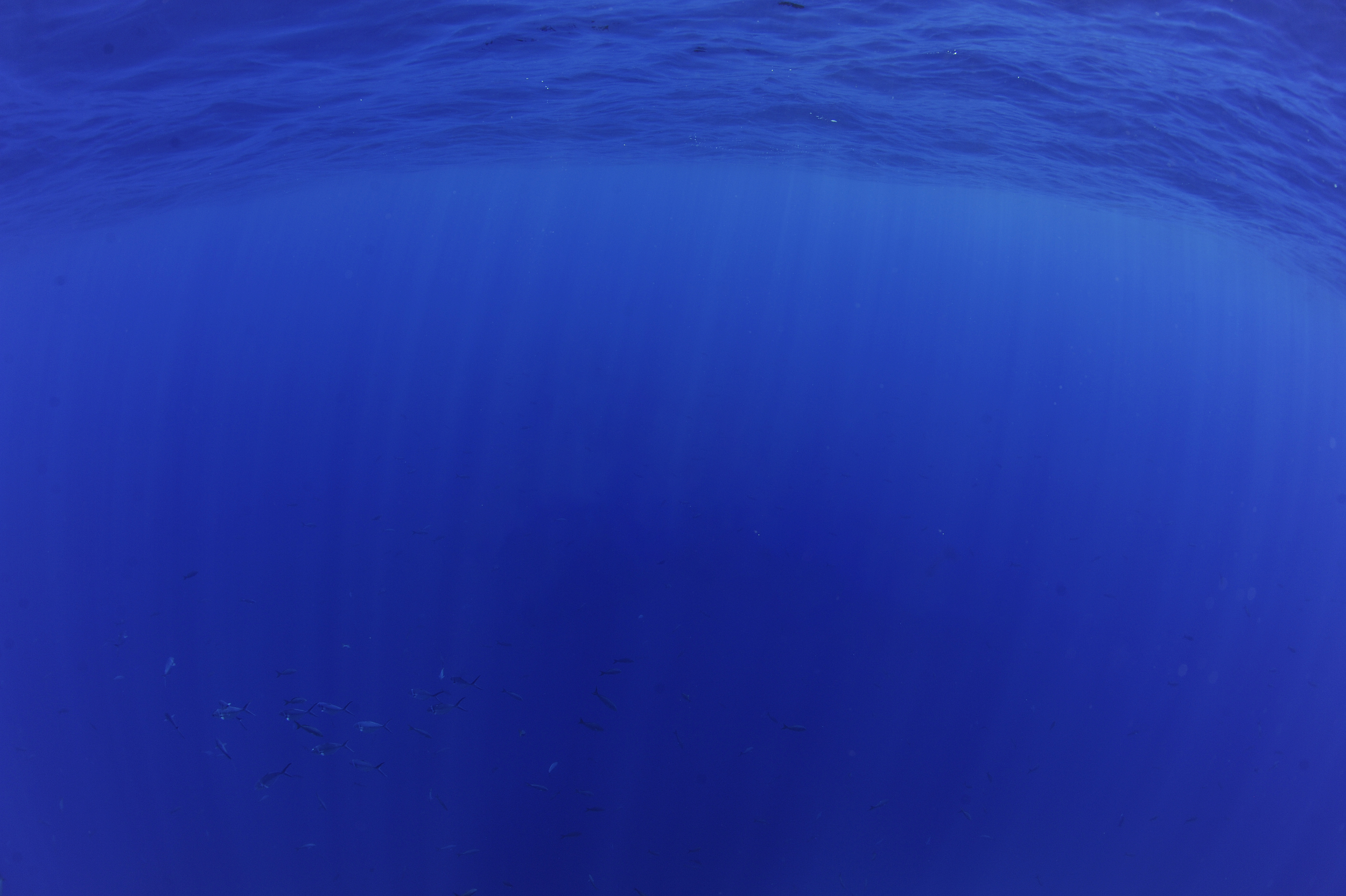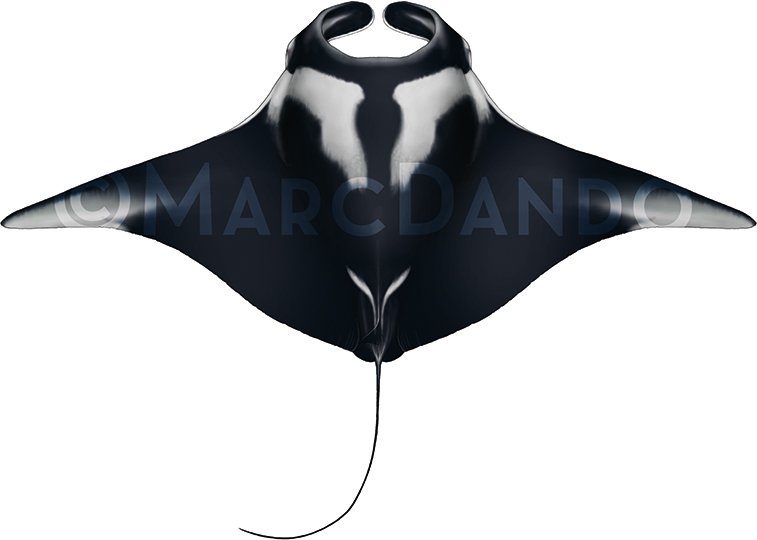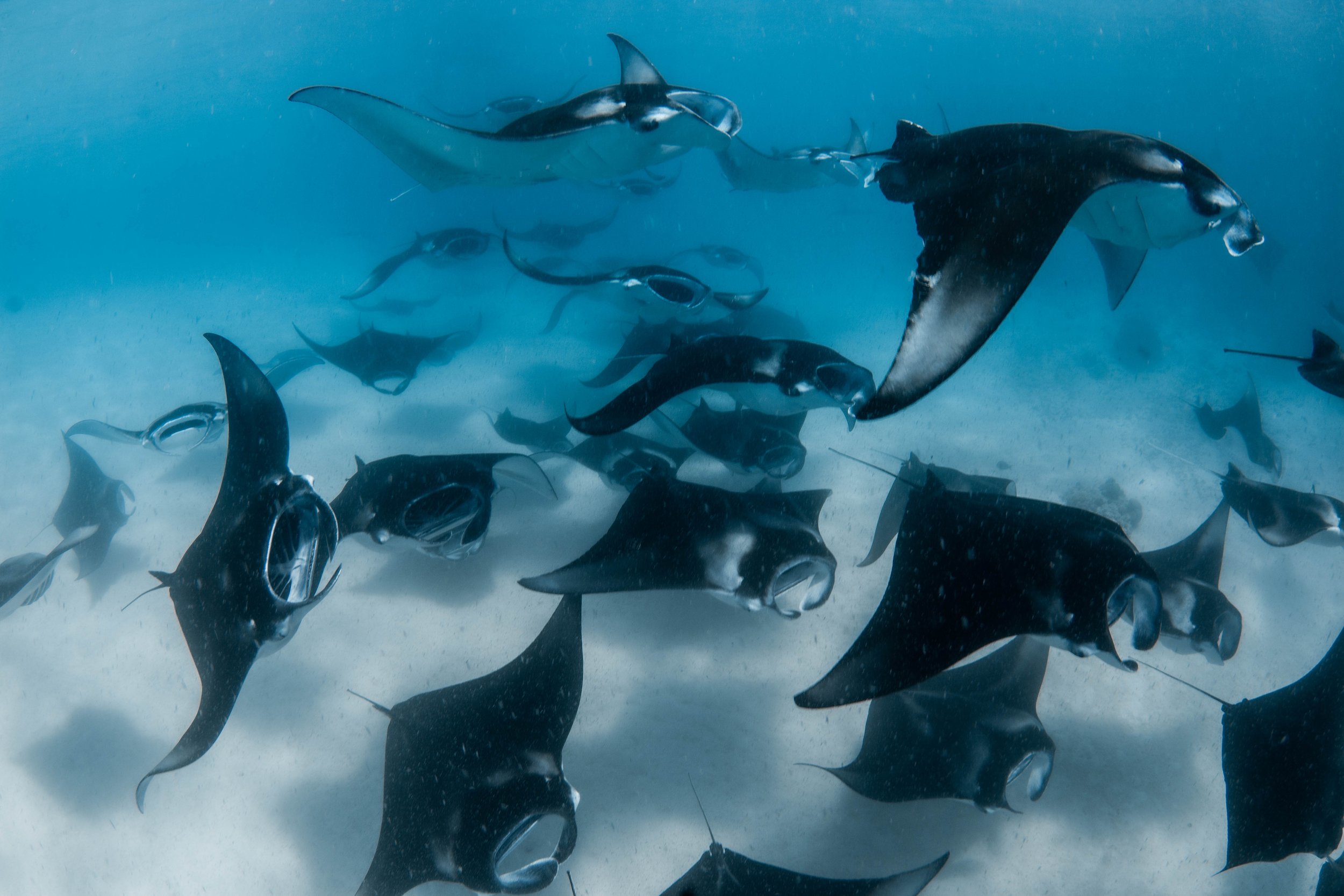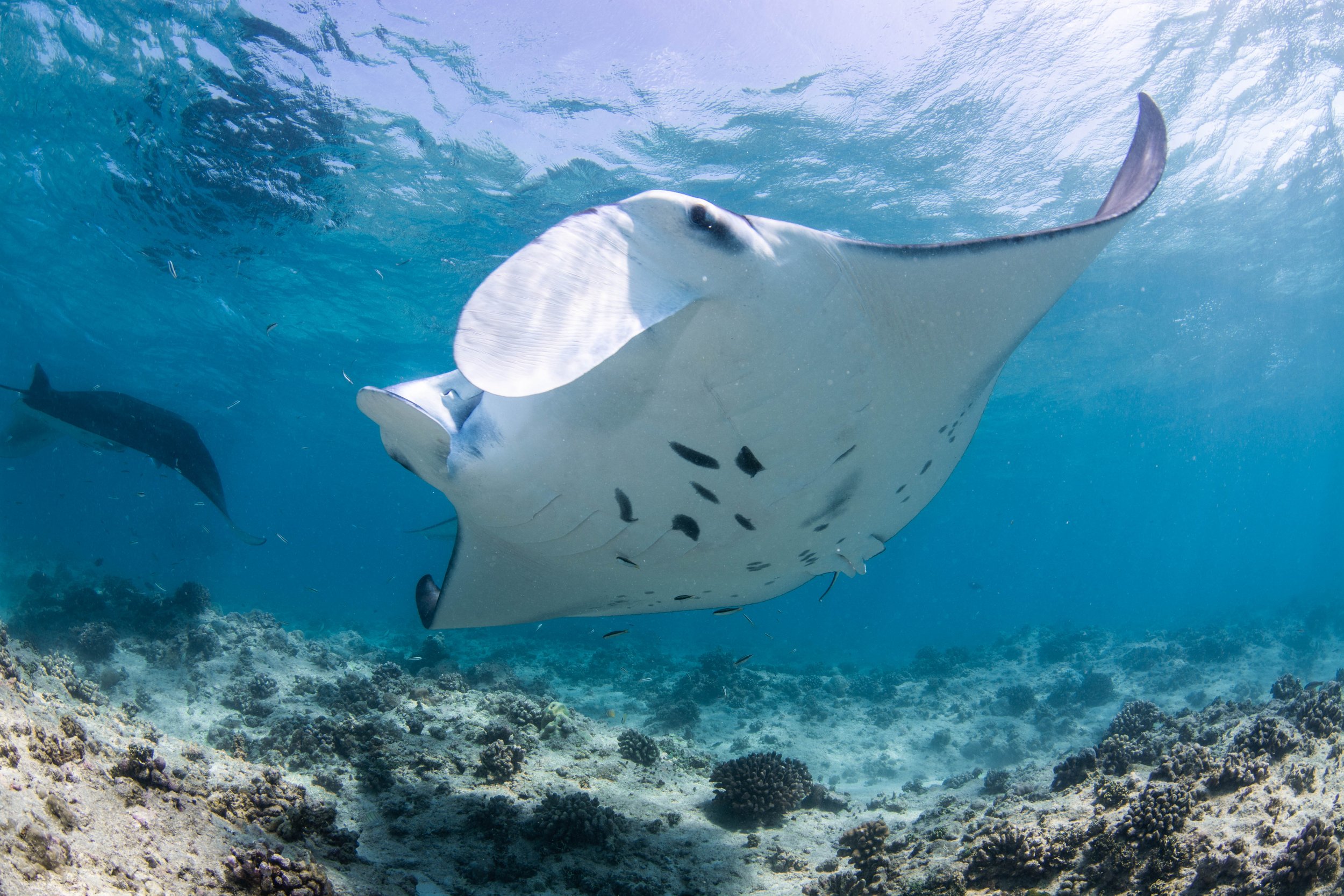
the mmCP at a glance
The Maldives Manta Conservation Programme (MMCP) consists of a country-wide network of researchers, educators, dive instructors, biologists, communities, and tourism operators, with roughly a dozen MMCP staff based across multiple atolls. Within these atolls, they conduct research from a combination of resort islands and local islands. On the map to the right, the dark atolls represent the focus study areas for the MMCP. However, our staff also regularly undertake research throughout the rest of the archipelago while onboard private research vessels and public liveaboard expeditions.
The MMCP collects data around the country's manta population, its movements, and how the environment and tourism / human interactions affect them. Since its inception, the project has identified over 5,500 different individual reef manta rays (Mobula alfredi), from more than 80,000 photo-ID sightings - many of which were submitted by members of the public via IDtheManta. This makes the Maldives reef manta population the largest, and one of the most intensively studied populations in the world. The project has also identified over 850 individual oceanic manta rays (Mobula birostris), most of which have come from Fuvahmulah Atoll.
The long-term and nationwide data collected by the MMCP has allowed researchers to record and identify key patterns within this population over time. Not only does this invaluable information improve our understanding of these animals, but it informs their on-going management and protection. Research driven by the MMCP has been fundamental to protecting manta rays and their most critical habitats within the Maldives, but has also played a significant role in gaining protection for populations in other corners of our oceans.
manta rays and the maldives
The Republic of Maldives has a massive resident population of reef manta rays (Mobula alfredi), and an annual migratory population of oceanic manta rays (Mobula birostris).
After 18 years of data collection, we estimate that the total population of reef manta rays for this small nation in the middle of the Indian Ocean is ~4,000 individuals - making it the largest known population in the world (by a large margin too!). The database of oceanic manta rays totals over 850 individuals, however, the population appears to be highly transient with individuals spending only short periods of time close to the reef, and rarely being re-sighted. Large aggregations have been recorded over a number of years, but continued observations are needed to confirm the timing and drivers of these aggregations.
The Maldives reef manta rays are year-round residents, migrating across the country’s 26 atolls in tandem with the changing monsoons and the resulting shifts in zooplankton abundance and distribution. These nutrient-rich waters support huge quantities of marine life, and it is not uncommon to find several dozen manta rays feeding in the shallow surface waters in and around the atolls. At the right time of year, some key sites such as Hanifaru Bay, play host to feeding aggregations of >150 mantas - sometimes with a whale shark or two joining in on the feast.
These spectacular underwater events, coupled with the diversity of marine life across the country, make the Maldives one of the best dive and snorkel destinations in the world. Every year the number of tourists travelling to the Maldives specifically to swim with charismatic marine megafauna has increased. These animals are therefore highly valued as a tourism resource in the Maldives, generating an estimated US$8.1 million annually in direct revenue for manta ray tourism alone. This type of tourism has clear significant benefits to the Maldives economy and for the wider-scale conservation of manta rays and the ocean - but as is the case with many natural resources, they continue to be stretched in this developing nation. The negative associated impacts of tourism are increasingly affecting the manta ray population and their habitat.

PROTECTED SPECIES
In the Maldives, all ray species are protected by law, and it is illegal to capture, keep or harm any type of ray. The export of all ray products was banned in 1995, and all ray species, including manta and devil rays, were added to the Maldivian National Protected Species List in 2014. With the economic value of rays in tourism and a national fishery that prohibits the use of nets which reduces the risk of mobulid bycatch, the Maldives prides itself in its successful conservation of ray species. This has led to a thriving population of manta and devil rays, of which the confirmed species identified in the Maldives, can be seen below.
For migratory species, such as the oceanic manta ray, the concern is how well they are protected in other countries’ waters. Sri Lanka, which is situated 300 kilometres to the north of the Maldives, is home to one of the largest manta and devil ray fisheries in the world. Fisheries research studies conducted by the Manta Trust in Sri Lanka have estimated that thousands of these threatened rays are landed every year across the country. The relatively close distance (1,000 km) between the oceanic manta ray aggregation site in the south of the Maldives and the extensive fishery in Sri Lanka is a cause for concern, especially as the Sri Lankan and other nations' fleets fish intensively throughout this region of the Indian Ocean. However, at present, we do not know the extent, if any, of the connectivity between these populations.
Seasonality and abundance
The reef manta ray and the shorthorned pygmy devil ray are the most commonly sighted of the manta and devil rays in the Maldives. They are both abundant throughout most of the country, with a year-round presence, whilst the oceanic manta ray is regionally common for just a few months a year in Fuvahmulah, one of the southernmost atolls. The other three devil ray species (spinetail, sicklefin and bentfin) are all rarely sighted, due to their predominantly oceanic lifestyle.
Click on the species below to learn more.
MALDIVES MANTA RAY marine Protected AreaS
The Maldives boasts an abundance of manta ray aggregation areas, of which many receive official protection in the form of marine protected areas. The MMCP has worked closely with the Maldives Government and the Environmental Protection Agency (EPA) to identify and designate protection for the following sites.
Hanifaru, BAA ATOLL
Hanifaru, which encompasses Hanifaru Bay, is one of the best locations in the world to swim with manta rays and is famous for its mass manta ray aggregations! Hanifaru Bay is situated within a marine protected area (MPA) on the eastern edge of Baa Atoll in the central atolls of the Maldives. Hanifaru in the local Dhivehi language translates to narrow ‘Hani’ reef ‘faru’.
Hanifaru Bay is a key aggregation site for reef manta rays (Mobula alfredi), which frequent this site primarily to feed, however, whale sharks (Rhincodon typus) have also been observed feeding here. Through photo identification, the MMCP has recorded over 1,800 individuals at this site during the last 18 years of research! This is also one of the few places in the world to witness manta rays cyclone feeding, with up to 247 individuals being recorded during one of these mass-feeding events.
Due to the unique structure of the bay’s outer reef, each year from May to December during the Southwest (SW) Monsoon (Hulhangu – local Dhivehi name), mass aggregations of feeding manta rays frequently occur inside the bay. Strong lunar tides overcome the force of the prevailing monsoonal current, sucking plankton-rich water from ocean depths outside the atoll back into the shallow atoll channels. In the channel next to Hanifaru Bay, these currents form a back eddy or reverse current, that traps and concentrates plankton in the shallow bay.
With the implementation of the Maldives Environmental Protection Agency (EPA) management plan in 2012, sustainable tourism practices and strict regulations are continuously being enforced within Hanifaru MPA. These include but are not limited to; tourist and boat limits, SCUBA and fishing bans, scheduled alternation of entrance days between liveaboards and resort boats, speed limits, and specified use of entrance and exit routes. EPA Biosphere Reserve rangers are based on-site to maintain the rules and regulations of the MPA. Such regulations and management initiatives are vital to ensure the efficacy of Hanifaru Bay in conserving the Maldives manta ray population, by minimising the harmful ramifications arising from human-manta ray interactions.
Hanifaru MPA which includes Hanifaru Island (bottom), lagoon (central), and Hanfiaru Bay (right hand side).
Mass feeding reef manta rays in Hanifaru.
ANGAfaru, BAA ATOLL
This large oval-shaped reef (Anga = mouth in Dhivehi) contains several manta ray aggregation sites. The main one is Dhigu Thila, which is a cleaning station for adult reef manta rays during the SW Monsoon. Feeding also regularly occurs at this site, as well as inside Angafaru Falhu and on top of Dhonfanu Thila. Due to its proximity to Hanifaru, mass feeding is often also seen at Angafaru.
VaVvaru, LHAVIYANI ATOLL
Reef manta rays (primarily juveniles) feed around the channels and inner reefs of Vavvaru marine protected area, primarily at a site called Dhanifaru during the Northeast Monsoon. Vavvaru also boasts a cleaning station at this site called Thin' Gaa. Rare creatures such as the hammerhead shark have been seen to frequent the outer reef. With it’s unique topography and multiple site functions, it’s no wonder this area is such a megafauna hotspot!
Fushifaru, LHAVIYANI ATOLL
Reef manta rays (adults and juveniles) feed in Fushifaru Kandu (channel) for several months each year towards the end of the SW Monsoon. Inside the channel, there are many ‘Thilas’ (submerged pinnacles), of which one is a renowned manta ray cleaning station named Fushifaru Thila.
Rasfari, NORTH MALE ATOLL
Reef manta rays (adults) frequent a shallow cleaning station on the outer reef crest at the northern end of the protected area (Rasfari Uthuru) during the Northeast Monsoon, between December to April. In the northern channel within the protected area there is also another less frequented cleaning station on Boduhithi Thila, where mass surface feeding events occur.
GURAIDHOO, SOUTH MALE ATOLL
Juvenile reef manta rays feed in the sheltered lagoon (Guraidhoo Falhu - also known as Sand Dunes) during the Southwest Monsoon, between May to November. There is also a cleaning station within the lagoon (known as Banana Reef).
RANGALI KANDU, ari ATOLL
Within the Kandu (channel) is the famous Rangali Madivaru Cleaning Station. Adult reef manta rays frequent this site during the Northeast Monsoon, between December to April. With an abundance of healthy corals, this is a particularly favoured spot for divers. There is occasionally surface feeding seen at this site as well.
FUSHI KANDU, LAAMU ATOLL
Reef manta rays (both adult and juvenile) visit a cleaning station in Fushi Kandu for several months each year during the Southwest Monsoon. Surface feeding is also sometimes recorded at this site, which is often seen by surfers that ride the waves on the channel corner. Grey reef sharks, eagle rays, and schooling fish are regulars to this abundant site.
FARIKEDE, FUVAHMULAH ATOLL
Adult oceanic manta rays pass through this reef plateau for just a few weeks each year during the Northeast Monsoon, with peaks in sightings during March and April. No feeding or cleaning has been observed, so it seems that these rare and unique animals appear to be migrating through the area.
MAA KANDU, ADDU ATOLL
Within the kandu (channel) is the famous Mudakan Manta Point Cleaning Station. Adult and juvenile reef manta rays use this site year-round. The manta rays frequenting this site are particularly friendly with divers and love to hover above the bubbles to receive a ‘bubble massage’. No feeding has been observed at this site.

RESEARCH ACTIVITIES
Throughout the MMCP bases, our team utilizes a wide variety of well established and innovative research methodologies to achieve our conservation goals.
PHOTOGRAPHIC IDENTIFICATION
Manta rays have a unique spot pattern on their ventral surface (belly), which can be used to identify them. By taking photographs of these spots, and profiling individuals, the team can track manta ray population numbers, movements, physical changes and more!
CONTACTLESS UNDERWATER ULTRASOUND
The Manta Trust and MMCP team in collaboration with partners, developed the world’s first contactless underwater ultrasound scanner that allows researchers to see if a female manta ray is pregnant, and to study the development of the foetus, in a non-invasive way.
STEREO-VIDEO-PHOTOGRAMMETRY
Our teams have been using a device called a Stereo-Video-Photogrammetry system, two go-pro cameras calibrated to take accurate wingspan measurements of manta rays. By taking repeated measurements of manta rays, the MMCP can understand their size at maturity and growth rates.
REMOTE UNDERWATER PHOTOGRAPHY
The MMCP wants to know if manta rays use reef habitats differently when divers/snorkelers are present and to deepen their understanding of how temporal scales affect manta ray activity. Underwater time-lapse gopro cameras give them new insight into manta ray behaviour and habitat use so that they can provide vital scientific guidance to the Maldives communities, businesses and government; helping them to protect the local manta ray population on which their economy depends.
PLANKTON SAMPLING
Manta rays feed on microscopic zooplankton. The MMCP is investigating the zooplankton species diversity and abundance in key manta ray aggregation areas, to better understand the diet of manta rays and determine which species they have a preference for and in what numbers. They are also monitoring the zooplankton to help understand the possible impacts of the climate crisis on a warming ocean, which is likely reducing the abundance of the manta ray's food.
ENVIRONMENTAL PROFILING
Through monitoring the physical oceanographic conditions in manta ray habitats, the MMCP is gaining insight into the varying environmental conditions and physical properties that are driving manta ray behaviour and influencing zooplankton availability.
LOCAL ECOLOGICAL KNOWLEDGE SURVEYS
By conducting semi-structured interviews with fishers and community members of the atolls the MMCP research in, they are aiming to determine the communities' understanding of manta rays, awareness of and attitude towards conservation regulations, and determine if any anthropogenic pressures are threatening such species to identify how management can aid their conservation. The collaboration of knowledge between local communities, scientists, and management projects has the potential to bridge gaps in baseline data, to develop a broader understanding of manta rays and improve relations and community support for the conservation of a valuable and vulnerable species.
Endocrinology
The MMCP is non-invasively collecting manta mucus to assess hormone concentrations to identify their roles in sexual maturity and reproduction. They will use the findings to help pinpoint when reef manta rays reach sexual maturity and when their breeding seasons occur so that they can suggest ways of improving their population viability.
ANIMAL TELEMETRY
Due to the vast horizontal and vertical distances that manta and devil rays cover, tracking these species through photo identification alone has its limitations. The use of telemetry has provided important insight into the movement and behavioural ecology of manta and devil rays for the MMCP, which has been used to aid effective conservation strategies in the Maldives.
GENETICS
DNA provides a unique window into the past, present and future of a species. The MMCP can use it to understand the evolutionary history of manta and devil rays, and characterize patterns of population structure through genetic sequencing.

Through our Marine Education Programme, we are fostering the next generation of Maldivian ocean ambassadors, who will take stewardship of their island environment.

PROJECT GOALs
The MMCP was founded with the goal of learning more about the life cycle, population dynamics and habitat usage of the Maldives manta ray population, whilst also working with the government, tourists, local communities and tour operators to create greater appreciation and protection for these ocean giants and their habitat and drive conservation at a local level.
LEARN MORE ABOUT MANTA RAYS
To achieve this goal, the MMCP works to meet the following research objectives:
(1) To continue the ongoing programme of monitoring the numbers and identities of individually recognisable reef and oceanic manta rays (Mobula alfredi and Mobula birostris) in the Maldives and to ascribe to these individuals data on size, growth, maturity, scarring, reproductive activity and movement.
(2) To analyse the data from above in order to; assess the effective population size of the reef and oceanic manta rays; assess the apparent ranges and movements of these animals; assess the apparent turnover of the population (rates at which individuals join or leave the population), and relate this to the possible rates of recruitment and mortality; to determine the apparent rates of mortality (disappearance of individuals) in the population, and relate these to the rates and types of injury.
(3) To collect environmental data which might bear an influence on the numbers of manta rays observed.
(4) To collect plankton samples to assess manta rays’ prey composition and density fluctuation in order to further our understanding of reef manta rays’ dietary preferences, as well as assess the relative importance of key aggregations sites such as Hanifaru Bay MPA as a foraging ground for the Maldives manta ray population.
(5) Record any signs of reproductive activity among manta rays at key study areas, or any other site in the Maldives, including any indications of courtship or mating behaviour and the appearance of pregnancy or mating scars in female manta rays.
(6) Evaluate the social dynamics and behaviour of an unfished population of manta rays in the Maldives.
(7) To continue to record the extent to which snorkelers/divers appear to alter the behaviour of the manta rays and to assess positive and negative impacts.
(8) To monitor anthropogenic pressures - accounting for direct effects (boat/ propeller strikes, fishing line entanglement) and indirect effects (noise pollution) on manta rays.
increasE appreciation & protection
To achieve this goal, the MMCP works to meet the following conservation objectives:
(1) Continuously assess any threats to the reef manta ray population and their habitat, by monitoring tourism activities at key aggregation sites and recording incidences of targeted or accidental injury.
(2) Continue to record the extent to which tourists appear to alter the behaviour of the manta rays or impact their welfare and the extent to which guidelines for wildlife tourism are being observed or neglected.
(3) Push for the implementation of national protective legislation for manta rays and their key aggregation sites within the Maldives.
DrivE Conservation Locally
To achieve this goal, the MMCP works to meet the following capacity-building objectives:
(1) Provide educational outreach for Maldivian children and young adults on the environmental issues facing their communities and engage them with conservation solutions.
(2) Increase our work on inhabited islands, ensuring that all MMCP conservation initiatives benefit Maldivian communities, and benefit from their vital local knowledge.
(3) Provide training, mentorship and job opportunities for Maldivians who want to work in marine research and conservation.
OCEANIC MANTA RAY PROJECT GOALS
To better understand the population dynamics of oceanic manta rays throughout the Maldives Archipelago, and assess the possible connectivity between the population recorded in the Maldives and the population being fished in neighbouring Sri Lanka.
Additionally, the project hopes to increase our awareness of this transient species in the Maldives by conducting outreach and education programmes with local schools and communities.
To achieve these goals, the Maldives Oceanic Manta Ray Project works to meet the following objectives:
(1) Continue to build upon the photo-ID database of oceanic manta rays in the Maldives;
(2) Track a selection of oceanic manta rays with critter cams to determine spatial and temporal movements and habitat use of this species around Maldivian waters;
(3) Collect tissue biopsy samples from a selection of oceanic manta rays in order to conduct stable isotope, fatty acid, and genetic analyses and comparisons with individuals fished in Sri Lanka;
(4) Increase education and awareness within the Maldives of oceanic manta rays and the threats they face throughout the Indian Ocean;
(5) Help advise the relevant government bodies on appropriate measures to be taken to protect oceanic mantas from unsustainable tourism.

Key Achievements
Identified over 5,500 individual reef mantas from >80,000 sightings, and over 850 oceanic mantas in the Maldives.
Drove the designation of two Marine Protected Areas in the Maldives; Hanifaru Bay and Anga Faru (2009).
Drove the designation of Baa Atoll as a UNESCO World Biosphere Reserve (2011). Supplied data that supported the designation of Fuvahmulah and Addu as UNESCO Biosphere Reserves.
Assisted government with development & implementation of a Management Plan for Hanifaru Bay MPA (2011), to minimise impact of tourism to the site.
Spear-headed the addition of all ray species, including manta and devil rays, to the Maldivian National Protected Species List (2014).
Created a research-backed Tourism Code of Conduct (CoC) to minimise the negative impacts of manta dive and snorkel tourism. Created a multi-media initiative (How to Swim with Manta Rays) to deliver this CoC effectively to tourists and operators (2017).
Past & CURRENT Students
MSc/Mres supported
31
PhDs supported
6
Kaitlyn Zerr (current)
Beth Faulker (current)
Jessica Haines (current)
Henry Gould
Hannah Cocks
Chris Wenham
Emma Hedley
Abigail Sehmi
Sam Matthews
Lotte Krüger
Lois Flounders
Elspeth Strike
Aimee Nicholson-Jack
Joanna Harris
Nicole Pelletier
Flossy Barraud
Ella Garrud
Nicola Bassett
Jenny Stark
Zofia Drapella
Jenny House
Tam Sawers
Georgia Coward
Annie Murray
Bex Lynam
Rebecca Atkins
Katie Lee Brooks
Tim Davies
Luiza Neves
Kelly Timmins
Gareth MacGlennon
Flossy Barraud (current)
Niv Froman (current)
Hannah Moloney (current)
Dr. Asia Haines
Dr. Annie Murray
Dr. Guy Stevens

meet the team
ZOONA NASEEM
Board Director - Co-Founder
MOOSA MOHAMED
Board Director - Co-Founder
MAEESHA MOHAMED
Board Director - Co-Founder
TAM SAWERS
Maldives Project Leader
MOHAMED FAUZ FATH-HEE
RahVeshi Programme Coordinator
NUHA RASHEED
Maldives Education Manager
MIRIAM STAIGER
Project Manager -
Laamu Atoll
ZAKWAN ZAMEER
Assistant Project Manager - Laamu Atoll
ELLIE STRIKE
Project Manager -
Baa Atoll
TIFF BOND
Assistant Project Manager - Baa Atoll
TIANA WU
Project Manager - Makunudhoo Atoll
UMAR IBRAHIM
Research & Outreach Assistant - Makunudhoo Atoll
MERAL HAFEEZ
Project Manager - Raa Atoll
EMILY HOAD
Assistant Project Manager - Raa Atoll

partners in the maldives
Four Seasons Resorts Maldives have supported the Manta Trust since the inception of the Maldives Manta Conservation Programme in 2005. Working alongside the Four Seasons the MMCP has been able to share the experience of snorkeling with mantas with thousands of guests as well as providing educational talks and activities. The Four Seasons Resort at Landaa Giraavaru is the main base for the MMCP, and during the manta season the resort is home to MMCP and annual interns as they go about their research. Four Seasons Resorts, Maldives are committed to sustainable tourism practices, and were instrumental in the designation of Baa Atoll as a UNESCO World Biosphere Reserve.
“Here at Four Seasons Landaa Giraavaru, we feel a great source of pride to have hosted the founding project of the Manta Trust and to have been supporting the work of the charity for nearly 20 years, helping to protect the beautiful mantas of the Maldives.”
Armando Kraenzlin - General Manager & Regional Vice President
Four Seasons Resorts Maldives
Six Senses Laamu is one of the MMCP's longest partners. Fully committed to the environment and developing sustainable, marine-related guest activities, Six Senses has contributed to the MMCP’s research since 2012. The Six Senses now extends it’s conservation opportunities to it’s guests by hosting MMCP staff on-site throughout the year.
InterContinental Maldives Maamunagau Resort is the MMCP's newest partners. The resort, situated in the south east of Raa Atoll, provides our research team with access a number of incredible manta sites across southern Raa. The resort lagoon is visited by a number of manta rays each year and could possibly be an important nursery ground.
"We have been working with Manta Trust since the opening of the resort in 2019. They did a wonderful job in establishing the Manta Trust base at Intercontinental Maldives Maamunagau Resort and it is a great pleasure to be able to support their valuable research as they also involve our guests with their educational programmes. Their passionate and engaging team is a great asset to our resort and the guest experience we offer here."
Coetzer Deysel - General Manager
Intercontinental Maldives Maamunagau Resort
Baa Atoll UNESCO Biosphere Reserve was set up to manage the protection and sustainable use of Baa Atoll. Our MMRP team works closely with the biosphere reserve on a range of activities including data collection and education and outreach workshops.
Support MANTA ray RESEARCH In the Maldives
With your support, we can continue to learn more about this mysterious population of mantas!
SHOP
Check out our sustainable manta merchandise and help to support manta ray research in the Maldives.
DONATE
Make a donation to support our core initiatives and charitable aims, including research and conservation in the Maldives.
SPONSOR
Sponsor our one of our research or conservation projects and we’ll design a tailored sponsorship package to best benefit your business.
CYCLONE
Join a community investing in manta and devil ray conservation. Membership supports our work, including research in the Maldives.

Project Reports
The Maldives Manta Conservation Programme (MMCP) was formerly named the Maldivian Manta Ray Project (MMRP). Any reports published before 2022 will refer to MMRP throughout.
Baa Atoll
Raa Atoll
Maldives Oceanic Mantas
Laamu Atoll
Ari Atoll
Lhaviyani Atoll
North and South Male Atolls

Photos from the field

in the media















































































